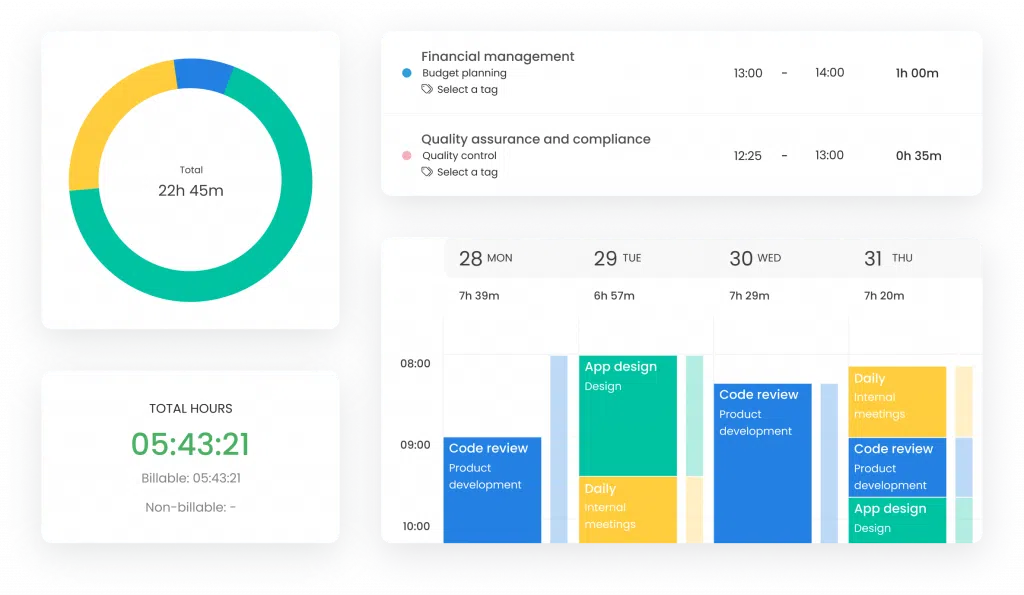Flextime: What It Is and How to Manage It
-
Lorea Lastiri
- July 11, 2024
- 10 min read

Flextime is an arrangement where you give your workers flexible working conditions. Flextime enhances your employees’ health, work-life balance, and performance. To manage flextime, you will need to create clear policies and keep track of productivity with software.
People have started to prefer flexibility in their workplace over standard working arrangement. A team with the freedom to choose location and time of work will boost performance and build a better business.
This article will discuss flextime and how it benefits both employees and employers. You’ll also learn how you can apply flexible working arrangements in your company.
Let’s dive in!
What Is Flextime?
Flextime is a schedule that creates flexible working conditions where employees can change their work hours (start and finish times). Flextime arrangements help an employee connect their personal lives and work for a better work-life balance.
Traditional schedules and flextime both involve the same number of work hours. The key difference is that flextime includes a core period during which employees must be present. Outside of these core hours, employees can choose when to work, as long as they complete their required daily hours.
The flexible working arrangement is particularly beneficial for employees who need to balance work with other responsibilities, such as childcare, commuting during off-peak hours, or personal errands. It also helps employers improve job satisfaction and retention by offering a more adaptable work environment.
Read our article on how many hours you should work a day.
What Is an Example of Flextime?
An example of a flexible schedule is allowing employees to work from 11 AM to 7 PM or from 8 AM to 4 PM, instead of the traditional 9 AM to 5 PM.
Here are other examples of flex time options available in companies:
- Job sharing is the oldest form of flexible working. Two part-time workers work half the time of one employee. Job sharing works when you communicate efficiently.
- Flexible workweeks are where employees change from working a five-day to a four-day week. On the other hand, they can work for ten days and take four days off. Or work for ten days (10 hours) and take three days off. As an employer, your company’s needs to determine the limitations in flexible work weeks.
- Comp time is when a company has busy season and people work more than 40 hours. Instead of receiving overtime pay for extra hours worked, employees employees can use the extra hours they’ve worked to get time off later, rather than receiving extra pay.
- Remote work is where an employee does not have to be physically present at the job site every day. Your team can engage in remote work if the office is noisy or too small.
- Part-time work shortens the eight-hour day into fewer hours, usually four to six. It’s offered mostly by companies who need an extra pair of hands but not for overtime hours.
Flexible work hours are most popular among parents, caregivers, people with illnesses, students, freelancers, and anyone looking to gain experience, transition back into the workforce, or simply seek better work-life harmony.
![]()
How Does Flextime Work?
Flextime requires an employee to work a specific number of hours within a given time, for instance, 40 hours in a workweek. However, some employers adopt a results-oriented approach, prioritizing task completion over tracking the number of hours employees work. Instead of monitoring employee’s work hours, these employers set specific deadlines for tasks, believing this method enhances overall performance and productivity.
Note that flexible working is only for exempt employees. Exempt workers receive a salary and are free from overtime rules and minimum wages. Flex time works optimally for highly individualized work or when information technology makes asynchronous collaborations possible.
Workplace flexibility does not mean that the number of hours worked decreases. Core hours are when people are expected to be at the job site. The core period changes depending on an employee’s position or department.
Flexible work arrangements are successful when they serve the needs of both employees and employers. The focus of flex time is job productivity and reaching business goals.
Below, you’ll find a short guide on how to prepare a flexible work schedule (read the full article here):
1. Request and approval of flex time
Your employee can request a flexible work arrangement by submitting a formal proposal to you or human resources. Managers or unit heads have the authority to approve these flextime arrangements. Flexible schedules are typically started on a trial basis and can be discontinued by either the managers or the employees.
Alos, departments also have the right to terminate the schedule due to unforeseen issues or concerns about employee performance.
If you and your employee agree on the flexible schedule, the worker must fill the flexible work schedule form. Documenting the agreements with a date for review, modifications, or renewals is crucial. You should also make two copies of the form; for you and the worker.
2. Considerations for granting flextime
Factors like space, health and safety, staffing patterns, and operational needs can prevent you from giving employees flex time. Employees must agree to change their work hours when they or their supervisors make requests. Sometimes, workers are needed to travel or work outside the flexible schedules.
Many employees can request flexible work arrangements that a department can manage. Here, the supervisor will decide how to handle the situation reasonably and in the best interest of employees and the company.
3. Employees and employers assume responsibilities
The employee and the department must complete the flexible work schedule form so the regulations of the flextime arrangement can go into effect.
Discussions and revisions are necessary before any changes. A worker will work on the agreed number of hours and need approval from the department before working overtime. You need to maintain open communication with employees who perform within their required time frame.
What Are the Benefits of Flextime?
Flextime can benefit both employers and employees. Employees prefer workplace flexibility to advancements or compensations. On the other hand, employers like giving their teams flextime because it utilizes less money than promotions and raises.
![]()
Flextime benefits for employers
There are many ways flexible work arrangements can benefit you and your company. Here are the reasons why you should offer flex time to your workers:
Create work-life balance with flexible working hours
Flextime arrangements give your employees more time to spend on their personal needs. Such a schedule allows employees more personal time and creates an outstanding work-life balance (see why). It also shows that you appreciate and trust your workers. You will have greater employee loyalty and build long-term relations.
Flextime policy attracts top talent to your company
Employees are intentionally looking for a business that offers workplace flexibility. By providing flextime in your company, you will attract top-performing candidates. You will get a better chance to find and employ the best people.
It provides a safe working environment
Offering flexible working means that employees don’t have to share office space simultaneously. Uncrowded spaces provide healthy benefits for employees. They decrease the chance of infections and make the workspace safe for everybody.
Uncrowded spaces also mean more silence and good conditions for deep work that requires focus and attention.
Flextime enhances performance
Organizations that allow people to have flexible working hours have greater performance. Flextime is associated with reduced stress and higher satisfaction among workers. Employees with lower stress tend to have high motivation and functioning levels.
A flextime arrangement improves cost-efficiency
Flextime can allow your business to save money. If most of your team members work remotely, you can decide to get smaller office space which reduces rent. Additionally, you save on energy and office supplies. You will also have lesser costs of employing new people because your workers are committed to your workplace.

Flextime benefits for employees
Flextime also has advantages for the employees. Here is how flextime workers benefit:
It enhances work-life balance
Flexible hours give employees more time to attend to their personal lives while still working. They don’t have to stay in the office for eight hours before tending to personal needs. Flex time management allows workers to have a work-life balance to manage their professional and personal lives.
Work-life balances ensure that your workers take care of their children, read books, and spend time in the park. As such, employees become more productive.
Flexible working arrangements improve employees’ health
Long commutes, inflexible work arrangements, and prolonged sitting can take a toll on your workers’ health. A flexible working schedule helps your team members avoid long commutes, traffic, and stressful work environments.
Engaging in remote work once in a while can create a significant difference for tired employees. Flexible working also allows your workers to take care of their physical and mental health and re-energize.
Flexibility gives workers more opportunities for improvement
Flexible working allows people to realize their full potential in their careers quickly. Workers have more time for self-improvement. Your team will have time to study and attend classes in school because they have their own work schedule. They stay motivated and have excellent performance levels, which increase the chances of a promotion.
What Are the Challenges of Flextime?
The flextime policy has many advantages, but it challenges both employees and employers.
Flextime challenges for employees
Employees also face challenges when it comes to flextime. Some don’t know how to take advantage of flex time. Some employees struggle to excel in their work unless they are in the office environment. Here are the challenges that employees face with flexibility:
Workers don’t know how to use flextime
Working with flex hours only works when everyone participates. Companies ensure everyone takes part by making human resource management policies. However, both employees who use flextime and those who don’t can experience stress. The human resource team can resolve this by giving everyone flextime benefits while maintaining clear communications.
Employees who like the office environment don’t thrive
Some people like working in office environments. They find it hard to cope when other employees don’t have similar work plans. Work that needs team effort will take days to plan and coordinate due to employees’ different working times. To accommodate ample time for teams, incorporate core days or hours when everyone gets to meet.
No clear definition between home and work
Flexible schedules could mean that you work all the time. When supervisors give employees flex hours to handle their personal lives, they can expect them to work odd hours. Your organization needs clear guidelines on flex-time to avoid straining any employee and employer.
Relationship problems with close people
Very often, when employees work remotely, their friends, neighbors, and relatives think they are not working. Close people in their lives will think they are free because they are home all day. Relationship problems arise when close people need favors that the worker cannot grant, such as babysitting.
Flex time challenges for employers
Flex time can prove challenging for you when there is little communication with the team. Supervisors can also have trouble adjusting to the new style. Here are some of the challenges that employers face with flextime:
Poor communication with employees
The main problem with flex time is poor communication. The different timings can cause issues with meetings, training, and interviews. HR can develop specific core hours when people address projects as a team.
Head departments take time to get used to the new management style
Unit heads who are used to seeing team members at work and watching how they work can have trouble coping with flex time. The supervisors will need to trust their team and set guidelines for departments. This way, they can use policies to manage the team’s different working plans.
![]()
How Do You Manage a Flextime Work Schedule?
You need to be transparent with your workers about flex time and ensure efficient communication. The first thing is to talk to your employees and ensure you’re on the same page. You also need to set clear guidelines and keep track of their time.
Here’s how you can manage your flexible workers:
1. Speak with your employees
Talk to your team before coming up with flexible hours for your workers. You might find that some of your team members will not benefit from the new work arrangements. To avoid doing unnecessary work, ensure that most people benefit and are on board. Also, interview every employee individually and as a group to get everyone’s perspective.
2. Create clear guidelines
Once your team members are on board, the next step is to establish clear guidelines. Setting guidelines will help your team stay connected and on the same page. Establishing core hours will enhance the sense of community among people with flexible arrangements (read why). Each worker will not feel lonely or isolated.
You should set the following standards:
-
Core hours—You should set hours when each employee needs to work because this helps with teamwork. You can set core hours from 10 to noon and ensure all meetings fall within these hours.
-
Acceptable working hours—Set a time frame within which employees can work, like from 6 AM to 7 PM.
-
Hour requirements—The number of hours a worker needs to fill every day, week, or month. Here, you will determine if an employee needs to reach eight hours every day or cover their 40 hours in four days.
3. Keep track of flex time with TimeCamp
With more workers choosing to work remotely, you need a way to measure performance and keep track of everything. You need a way to measure productivity. Here you can make use of software and applications.
TimeCamp is a time tracker that will help you automatically track your team’s productivity and project profitability. You will enjoy features like unlimited projects and users, 30+ integrations, and automated time tracking.
Here are ways TimeCamp can help you manage your flextime employees:
-
Keep track of your team’s performance in different projects—TimeCamp will track hours for your team so that you can focus on essential tasks.
-
Staying on the same page with your team—You don’t need to micromanage your team. They can self-manage their work with TimeCamp and boost performance.
4. Give your team freedom to schedule their flextime
You should allow employees to set times they prefer to have flex time. Let them fill out their preferred times before you finalize it. This way, your employees’ working lives correspond with their personal life. It will make it easy for you. If you allow your workers to set their time, you must consider that employees will work differently.
Make Scheduling Flexible Time Easy with TimeCamp
Flextime gives employees flexible working conditions to change their start and finish working hours. The worker still needs to work certain hours in a week. However, you can ignore traditional working hours and require your team to complete tasks within a certain period, especially during busy seasons.

Offering flex time for your team increases performance and improves work-life harmony. It also helps you use less money to motivate your team than giving a raise or promotion.
To create the best flex time arrangement, you need to develop clear policies and a way to keep track of flex time and performance.
Do you want to manage flex time and the productivity of your team?
TimeCamp will help you make scheduling flexible time easy through the following ways:
- Tracking your team’s performance: You can see how much time your team spends on a given task at a glance.
- Track your productivity: TimeCamp will help you track your team’s productive hours and measure the time they spend on websites and applications.
- Monitor attendance: See who works when at different hours to better schedule work.
- Track employee hours: Be it billable time, overtime hours, and time spent od different tasks.
- Supervise teams and projects: TimeCamp allows you to better manage team, workload, and workflow.
- Manage timesheets: Check monthly hours of your employees to better manage flex hours. All in neat timesheets and customizable reports.
Do You Take Advantage of Flextime Schedule?
According to the McKinsey survey on remote work “when people have the chance to work flexibly, 87 percent of them take it”(see full results).
Undoubtedly, flexible workweek offers more benefits than disadvantages. From a better work-life balance to boosted employee morale, the flextime is valuable for both, the employer and employees.
How do you handle the work schedule of your employees? What is your favorite form of flextime? Let us know in the comments, we’d be happy to hear from you!


